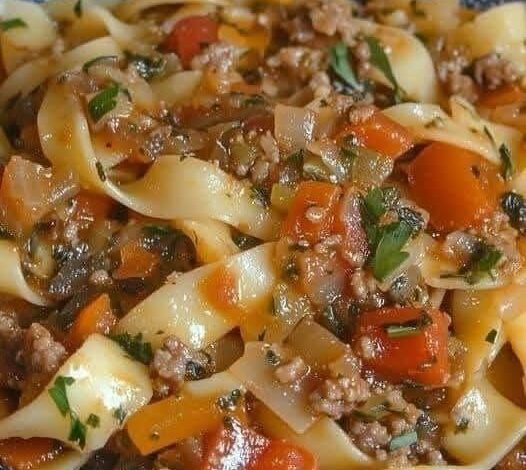Tagliatelle alla Bolognese – Classic Italian Meat Sauce Pasta


Introduction
Tagliatelle alla Bolognese is one of Italy’s most iconic dishes, originating from Bologna in the Emilia-Romagna region. This comforting pasta combines flat, ribbon-like noodles with a rich, slow-simmered meat sauce made from ground beef, pork, tomatoes, aromatic vegetables, and herbs. It’s a soul-warming meal that embodies the best of traditional Italian cooking—simple ingredients, cooked with love and patience.
Ingredients
For the Meat Sauce (Ragù alla Bolognese)
- 2 tbsp olive oil
- 1 tbsp butter
- 1 large onion, finely chopped
- 2 medium carrots, diced
- 2 celery stalks, diced
- 3 cloves garlic, minced
- 500 g (1 lb) ground beef (or a mix of beef and pork)
- ½ cup dry red wine (optional but recommended)
- 2 cups tomato puree or crushed tomatoes
- 2 tbsp tomato paste
- 1 cup beef broth (or water)
- 1 tsp sugar (to balance acidity)
- 1 tsp salt (adjust to taste)
- ½ tsp black pepper
- ½ tsp dried oregano
- ½ tsp dried basil
- ¼ tsp nutmeg (optional but authentic)
- Fresh parsley, chopped (for garnish)
For the Pasta
- 400 g (14 oz) tagliatelle or fettuccine
- Water + salt for boiling
- Grated Parmesan or Pecorino cheese (for serving)
Instructions
- Prepare the Base Vegetables (Soffritto):
Heat olive oil and butter in a large skillet or saucepan over medium heat. Add the onion, carrot, and celery. Cook for 5–7 minutes until softened and fragrant. - Add the Garlic and Meat:
Stir in the minced garlic, then add the ground beef (and pork if using). Cook until browned and crumbly, breaking it apart with a spoon. - Deglaze with Wine:
Pour in the red wine to deglaze the pan, scraping up the brown bits from the bottom. Let it simmer for 2–3 minutes until the alcohol evaporates. - Add Tomatoes and Seasonings:
Stir in the tomato paste, tomato puree, sugar, salt, pepper, oregano, basil, and nutmeg. Mix well. - Simmer Slowly:
Add the beef broth, stir, and reduce the heat to low. Let the sauce simmer gently for 45 minutes to 1 hour, stirring occasionally. The sauce should thicken and develop deep flavor. - Cook the Pasta:
In a large pot of salted boiling water, cook the tagliatelle according to package directions until al dente. Drain, reserving about ½ cup of pasta water. - Combine and Serve:
Add the pasta to the sauce. Toss well, adding a splash of pasta water if needed for a silky texture. Serve hot, topped with grated Parmesan and chopped parsley.
History of the Dish
Bolognese sauce has roots in the 18th century from Bologna, Italy. Traditional ragù was a slow-cooked meat sauce without heavy tomato use—later versions added tomatoes for richer flavor. Tagliatelle, a wide egg pasta, is considered the perfect partner for Bolognese because its flat surface holds the thick sauce beautifully.
Health Benefits
- Rich in protein: Ground beef and pork provide essential amino acids.
- Loaded with vitamins: Carrots and celery offer vitamin A and antioxidants.
- Energy booster: Pasta provides complex carbohydrates for long-lasting energy.
- Mood enhancer: The warm, hearty flavor can elevate mood and reduce stress.
Variations
- Vegetarian version: Replace meat with lentils or mushrooms.
- Spicy version: Add chili flakes or spicy Italian sausage.
- Creamy twist: Stir in a splash of cream or milk before serving for a silky texture.
- Gluten-free: Use gluten-free pasta or zucchini noodles.
Nutritional Information (Per Serving)
- Calories: 520 kcal
- Protein: 28 g
- Carbohydrates: 52 g
- Fat: 20 g
- Fiber: 4 g
- Sodium: 580 mg
Serving Suggestions
Serve with:
- Fresh green salad
- Garlic bread or focaccia
- A glass of red wine (like Chianti or Merlot)
Conclusion
Tagliatelle alla Bolognese is more than just pasta—it’s a comforting hug in a bowl. Its rich, savory sauce and tender noodles create a perfect balance of taste and texture. Whether shared at a family dinner or enjoyed solo on a cozy evening, this dish never fails to satisfy.



